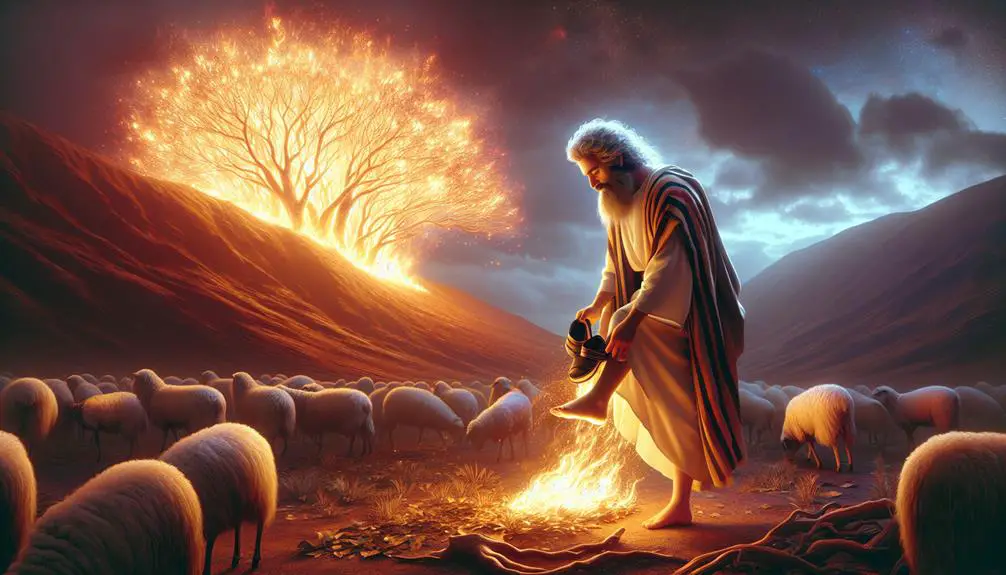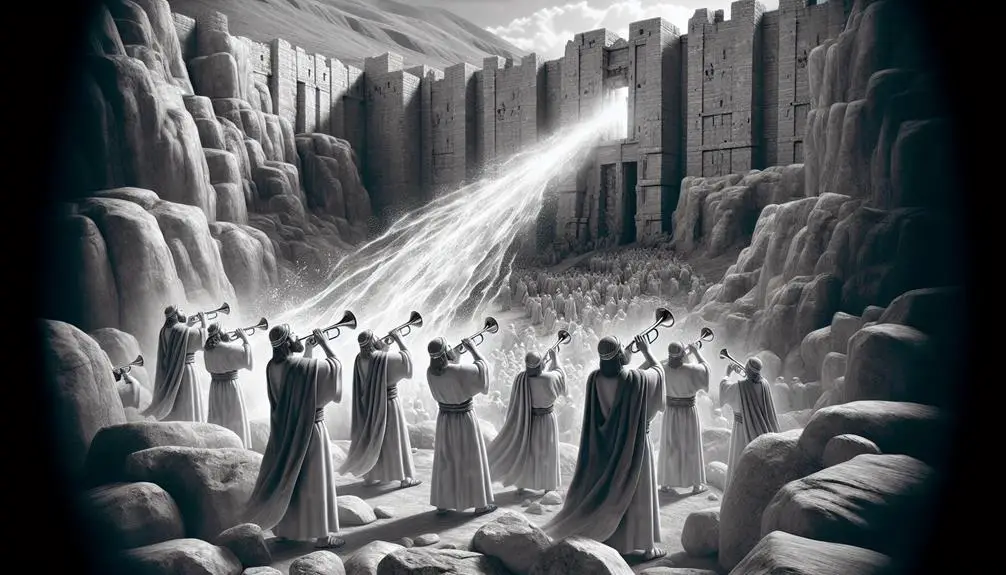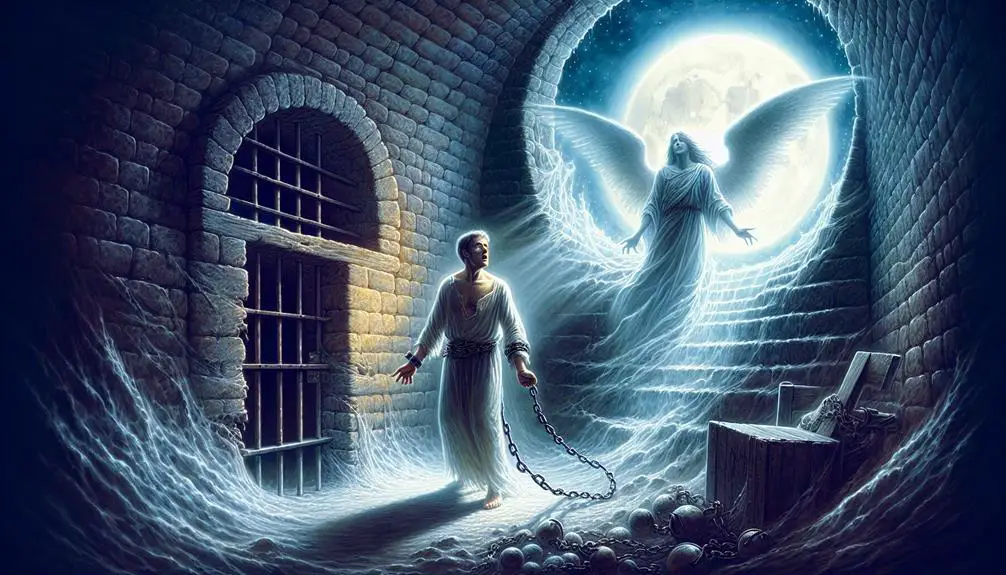A journey through the Bible's most unexpected moments, revealing the power and mystery of divine intervention in human history.

And Suddenly in the Bible
Just as lightning illuminates the sky without warning, the Bible is filled with moments of sudden divine intervention that forever alter the course of human history. You'll find yourself in awe as you consider the burning bush that spoke to Moses, or the blinding light that transformed Saul on the road to Damascus.
These stories aren't just ancient texts; they're profound lessons wrapped in mystery and wonder, inviting you to ponder deeper truths about faith, destiny, and the possibility of change. What might these sudden acts reveal about the nature of divine intervention in our own lives?
Key Takeaways
- Sudden divine interventions often mark pivotal moments leading to transformation or revelation.
- These moments frequently symbolize a deeper spiritual truth or lesson.
- Immediate obedience or humility in response to these events underscores their significance.
- Archaeological and historical analyses offer insights but also highlight the complexities of interpreting these sudden biblical events.
The Burning Bush Encounter

In the narrative of the Exodus, Moses' encounter with the burning bush symbolizes a pivotal moment of divine revelation and calling. This event isn't merely a historical or religious anecdote; it's a profound lesson on humility and obedience. As you delve into this account, you'll find that Moses' humility plays a central role in his interaction with the divine. Initially, Moses is hesitant to accept God's command, feeling unworthy and inadequate for the task at hand. This humility isn't a sign of weakness but an acknowledgment of his limitations and a reliance on a power greater than himself.
God's command to Moses to lead the Israelites out of Egypt comes from a burning bush that isn't consumed by the fire, a manifestation that defies natural explanation and demands attention. The command is direct and clear, leaving no room for doubt about the seriousness of the mission. However, it's Moses' humility that allows him to listen and accept this daunting task. His initial reluctance is overcome by a sense of duty and a trust in the divine command.
Analyzing this encounter, it's evident that Moses' humility and the clarity of God's command are intertwined. Moses' humility opens the path for him to receive and accept God's command, setting the stage for one of the most significant events in biblical history. This moment teaches that humility before the divine isn't just a virtue but a necessary condition for fulfilling one's destiny.
Saul's Road to Damascus

You must consider Saul's transformation on the road to Damascus as a pivotal moment that intertwines human choice with divine will. This episode not only marks Saul's dramatic conversion but also underscores the profound impact of divine intervention in biblical narratives.
Analyzing this event sheds light on themes of redemption, change, and the unforeseen paths that guide individuals towards their destinies.
Saul's Dramatic Conversion
Saul's dramatic conversion on the road to Damascus stands as one of the most pivotal moments in biblical history, often cited as a profound example of transformative spiritual awakening. This event marks a significant shift, not just for Saul, who'd become Paul, but for the early Christian community.
Key elements in this narrative include:
- Ananias' Obedience: Despite his reservations, Ananias follows divine instructions to assist Saul.
- Blindness Healing: Saul's physical blindness, symbolizing spiritual awakening, is miraculously cured.
- Baptism: Saul's baptism signifies his official entry into the Christian faith.
- Name Change: Saul becomes Paul, indicating his new identity and mission.
Analyzing this conversion, it's clear that individual transformation can have a profound impact on a community's direction and beliefs.
Divine Intervention Impact
Building upon the narrative of Saul's conversion, it's essential to explore how divine intervention played a pivotal role in shaping the early Christian movement. This miraculous event not only redefined miracle definitions but also set a precedent for intervention outcomes that would echo throughout Christian history.
Aspect |
Before Intervention |
After Intervention |
|---|---|---|
Saul's Belief |
Persecutor of Christians |
Devout follower of Christ |
Christian Movement |
Persecuted minority |
Gained a powerful advocate |
Miracle Definition |
Parting seas, burning bushes |
Personal transformation |
Intervention Outcome |
Immediate and profound change |
Long-term impact on Christianity |
Perception of Jesus |
False prophet |
Messiah and Savior |
This table highlights the transformative power of divine intervention, illustrating a before-and-after snapshot of both the individual and the collective faith journey.
The Fall of Jericho Walls

You'll find that the fall of Jericho's walls stands as a pivotal moment in biblical history, merging archaeological insights with sacred narratives.
By examining archaeological evidence, you gain a tangible connection to the events described, while exploring the biblical narrative provides a deeper understanding of its theological significance.
This analysis allows you to appreciate the multifaceted layers of history, faith, and evidence surrounding this iconic event.
Archaeological Evidence Examined
Regarding the fall of Jericho's walls, archaeological evidence offers a complex narrative that challenges traditional biblical interpretations. Unlike the stories of Noah's Ark or King Solomon's Temple, the tale of Jericho's collapse underpins significant historical debates. Here's why:
- Dating Discrepancies: Radiocarbon dating of materials from Jericho's site doesn't align with the biblical timeline.
- Architectural Analysis: Studies of the remaining structures question the biblical scale of destruction.
- Ceramic Evidence: Pottery pieces provide clues to the city's occupation periods, suggesting multiple layers of habitation.
- Stratigraphy Interpretations: Soil layers and their contents offer insights into the city's history, contradicting a singular event of collapse.
This archaeological scrutiny reveals the complexity of interpreting ancient events, where evidence often muddies rather than clarifies historical narratives.
Biblical Narrative Explored
Delving into the biblical narrative, the story of Jericho's walls tumbling down presents a faith-filled account that stands in contrast to archaeological critiques. This event, like the creation story and Noah's ark, intertwines divine intervention with human history. You'll find that such narratives offer more than historical claims; they convey moral and theological truths central to the faith.
Aspect |
Jericho's Fall |
Creation Story |
Noah's Ark |
|---|---|---|---|
Divine Action |
Yes |
Yes |
Yes |
Human Response |
Obedience |
Curiosity |
Righteousness |
Outcome |
Victory |
Life |
Salvation |
Moral |
Faith |
Responsibility |
Faith |
Historicity |
Debated |
Symbolic |
Symbolic |
The table above emphasizes the common threads weaving through these stories, highlighting their shared emphasis on faith, obedience, and the role of divine action in human affairs.
Jonah and the Great Fish

In the Book of Jonah, the narrative of Jonah's encounter with a great fish serves as a pivotal moment, illustrating themes of disobedience, divine intervention, and repentance. This story isn't just an adventurous tale but a profound lesson intertwined with maritime theology and the prophet's disobedience. Jonah's flight from God's command to prophesy against Nineveh and his subsequent punishment and redemption at sea exemplify the complexities of human defiance against divine will.
To understand the significance of Jonah's maritime ordeal, consider the following points:
- Maritime Theology: The sea in biblical literature often symbolizes chaos and disorder. Jonah's stormy encounter and ingestion by a great fish represent a divine intervention to bring order from chaos, not just in the natural world but within Jonah's spiritual journey.
- Prophet's Disobedience: Jonah's initial refusal to follow God's command highlights the theme of disobedience. His attempt to flee by sea underscores the futility of escaping divine will, a lesson that resonates through the ages.
- Symbol of Repentance: The great fish, often mistakenly identified as a whale, serves as a vessel for Jonah's transformation. His prayer from within the fish signifies repentance and submission to God's will.
- Divine Mercy: Jonah's deliverance from the fish's belly after three days prefigures themes of resurrection and redemption. It underscores God's mercy and readiness to forgive those who turn back to Him.
Through Jonah's story, you're reminded of the profound truth that divine intervention can come in the most unexpected forms, steering you back to the right path even when you stray.
Pentecost's Fiery Tongues

Just as Jonah's story underscores divine intervention through nature, the narrative of Pentecost reveals a dramatic spiritual intervention, where fiery tongues symbolize the descent of the Holy Spirit on the apostles. This event, occurring fifty days after the resurrection of Jesus, marks a pivotal moment in Christian theology, illustrating not only the fulfillment of Christ's promise to send an advocate but also the empowerment of the apostles through the Apostolic Gifts.
The descent of the Holy Spirit, manifesting as flames atop each apostle's head, signifies a transformative empowerment. This moment is critical in the formation of the early church, as it equips the apostles with extraordinary abilities, including speaking in tongues, healing, prophecy, and interpretation of dreams. These Apostolic Gifts serve as tools for the spread of the gospel, transcending linguistic and cultural barriers, and cementing the apostles' roles as foundational figures in Christianity.
Analytically, the Pentecost event can be seen as a divine strategy to universalize the Christian message. The fiery tongues not only symbolize purification and dedication but also the breaking down of barriers between the divine and the human. This moment of spiritual intervention showcases the Holy Spirit's role as both comforter and empowerer, bridging the gap left by Jesus' ascension.
In essence, the narrative of Pentecost and the accompanying fiery tongues underscore the Holy Spirit's crucial role in the establishment of the church and the dissemination of its teachings through the Apostolic Gifts. This event marks the birth of the Christian church, a community bound not by geography or ethnicity but by faith and spiritual empowerment.
Daniel in the Lions' Den

Daniel's ordeal in the lions' den showcases divine protection and the triumph of faith under dire circumstances. This narrative, deeply embedded in religious texts, presents an engaging exploration of faith testing and lion symbolism. Let's delve into the core elements that make this story significant:
- Lion Symbolism: Traditionally, lions represent strength, courage, and monarchy. In this context, they also symbolize the seemingly insurmountable challenges and threats to one's faith and integrity. Daniel's survival amidst these fierce creatures illustrates the power of divine protection over earthly dangers.
- Faith Testing: Daniel's unwavering commitment to his faith, even when facing death, serves as a profound testament to the strength and resilience of belief. His ordeal in the lions' den isn't just a test of his personal faith, but a demonstration of how steadfast faith can lead to miraculous deliverance.
- Divine Intervention: The narrative highlights the theme of divine intervention. Daniel's safety despite the presence of lions underscores the notion that faith can invoke divine protection in the face of grave threats.
- Moral and Ethical Integrity: Daniel's predicament arises from his refusal to compromise his spiritual principles. This aspect of the story emphasizes the importance of moral and ethical integrity, suggesting that true faith requires adherence to one's beliefs, even when such adherence might lead to personal risk.
Analyzing Daniel's experience in the lions' den offers insights into the complexities of faith testing and the symbolic use of lions in religious narratives. It underscores the belief in divine protection and the moral fortitude required to maintain one's faith in challenging situations.
The Angel Visits Mary

Shifting focus to another defining moment of faith, the angel's visitation to Mary introduces a narrative rich in themes of divine selection and human obedience. This pivotal event, often referred to as the Annunciation, underscores the profound intersection between divine will and human agency, encapsulated in Mary's consent to the angelic message.
The angelic message, delivered to Mary, is a testament to the divine choice of a humble human for a role of unparalleled significance in Christian theology. It's not just the content of the message that holds weight but the manner in which Mary's response is portrayed. Her consent, 'Behold, I'm the servant of the Lord; let it be to me according to your word,' exemplifies a model of faithfulness and willingness to participate in the divine plan, despite the uncertainties and potential societal repercussions it entailed.
This episode signifies a moment of radical trust and submission to divine will, setting a precedent for the theme of human obedience to God throughout the biblical narrative. It also highlights the role of women in biblical narratives, not merely as passive recipients of divine actions but as active participants in God's salvific plan.
Analyzing this encounter from a scholarly perspective, it's crucial to recognize the layers of theological and historical implications embedded within. The angel's visitation to Mary is more than a miraculous announcement; it's a narrative that challenges readers to reflect on the dynamics of divine-human interaction, the virtue of humility, and the power of consent in the unfolding of divine purposes.
Peter's Prison Escape

In the narrative of Peter's prison escape, we observe a compelling instance of divine intervention juxtaposed with human agency, illustrating a critical moment in the early Christian community's resilience and faith. This episode, rich in symbolism and meaning, showcases the pivotal role of faith in overcoming adversity, highlighted by the following elements:
- Angel's Guidance: The sudden appearance of an angel, who leads Peter out of prison, symbolizes divine intervention in times of despair. The angel's presence reassures believers that, even in their darkest hours, they aren't forsaken.
- Miraculous Freedom: Peter's chains falling away and the gates opening of their own accord represent not just a physical liberation but also a metaphorical release from the bonds of persecution and fear that the early Christians faced.
- Human Agency: Despite the miraculous nature of the escape, Peter's own actions—following the angel's instructions without hesitation—emphasize the importance of human cooperation with divine will. It's a reminder that faith requires action and obedience.
- Community's Response: The disbelief and astonishment of the Christian community upon Peter's return highlight the struggle between doubt and faith. Their initial skepticism, followed by joy, underscores the transformational power of witnessing God's work firsthand.
These elements together craft a narrative that transcends the mere act of escape, delving into the depths of faith, divine providence, and the human spirit's capacity to persevere. Peter's prison escape becomes not just a tale of miraculous freedom but a testament to the enduring power of belief in the face of insurmountable odds.
Frequently Asked Questions
How Did Cultural Perceptions of Divine Intervention Evolve in the Societies Surrounding the Biblical Events Mentioned, Before and After These Occurrences?
You're exploring how cultural perceptions of divine intervention shifted before and after biblical events. Ancient mythologies and the ritual significance tied to them played critical roles in shaping these views.
Initially, divine acts were seen as direct, personal interventions by deities. Post-biblical events, societies began interpreting such interventions within a broader, more symbolic framework, reflecting an evolution in understanding the divine's role in human affairs and the natural world.
In What Ways Have Modern Archaeological Findings Supported or Contradicted the Historical Accuracy of the Sudden Events Described in These Biblical Stories?
Modern archaeological findings have both supported and contradicted the historical accuracy of sudden events described in historical texts. You'll find that geographical discrepancies often challenge the locations mentioned, while chronological variations raise questions about the timing of these events.
Despite this, some archaeological evidence does align with historical accounts, providing a complex picture that requires careful analysis. It's crucial to consider these findings objectively, analyzing the evidence without preconceived notions.
How Have Various Branches of Christianity Interpreted the Theological Implications of These Sudden Events Differently, Particularly in Terms of Predestination and Free Will?
Different branches of Christianity interpret the theological implications of sudden events, like miraculous healings and angelic appearances, in varied ways, especially regarding predestination and free will.
While 60% might view these events as evidence of divine intervention guiding human destiny, others see them as affirmations of free will, where individuals are active participants in God's plan.
This divergence highlights the complex interplay between predestined paths and personal choice within Christian theology.
What Psychological Effects Might Individuals Experiencing Similar Sudden, Perceived Divine Interventions Undergo According to Contemporary Psychology, and How Do These Compare With the Biblical Narratives?
If you're exploring the psychological effects of sudden, perceived divine interventions, contemporary psychology suggests you might experience a range of emotions, from awe to distress, termed 'divine trauma.'
This contrasts with biblical narratives, where such events often lead to transformation or revelation.
The intervention impact can significantly alter your mental state, influencing your perception of control and destiny, much like characters in biblical stories, yet through a modern psychological lens.
Can Parallels Be Drawn Between the Sudden Events in the Bible and Similar Stories of Divine Intervention in Other Major World Religions, and What Do These Similarities and Differences Tell Us About Human Nature and the Search for Meaning?
Yes, you can draw parallels between sudden divine interventions in various religions and mythologies. These stories often share universal themes, like the quest for meaning and the struggle between good and evil, which reflect a deep-seated human need to understand the world.
The similarities and differences in these mythological parallels highlight our shared human nature and our diverse ways of seeking answers to life's big questions.
Conclusion
In analyzing these biblical events, it's evident that sudden divine interventions play a pivotal role in the narrative structure of the Bible. These moments aren't mere anecdotes; they symbolize deeper theological truths about faith, redemption, and divine will.
The pattern of God intervening in human affairs, often dramatically, underscores a fundamental aspect of Judeo-Christian belief: that God is actively involved in the world. This analysis invites further exploration into how divine immediacy shapes believers' understanding and interpretation of their faith.



Sign up